Generality
Zopiclone is a hypnotic sedative drug belonging to the class of so-called "Z drugs" (or "Z drugs"). It is considered a benzodiazepine-like drug, as it performs its action in a similar way to benzodiazepines.

Zopiclone - Chemical Structure
Zopiclone is marketed as a raceme; the activity of the drug, however, is due only to the enantiomer S. In fact, in the United States the pure S enantiomer is marketed with the name of Eszopiclone.
Indications
For what it uses
The use of zopiclone is indicated for the short-term treatment of insomnia.
Warnings
Benzodiazepine-like drugs - such as zopiclone - should be used in the treatment of insomnia only when it is a very serious and debilitating disorder for the individual.
Zopiclone treatment should be as short as possible.
A lot of caution should be used when administering the drug in patients who have a history of alcohol and / or drug abuse.
In elderly patients, adjustment of the dose of medication administered may be necessary.
Caution should be exercised when administering the drug to patients whose respiratory function is impaired, as the drug may induce respiratory depression.
Zopiclone should not be used alone for the treatment of anxiety associated with depression.
Zopiclone should not be used in patients with severe hepatic impairment.
The drug should not be used as a first-line treatment in psychotic conditions.
Zopiclone should not be used in children and adolescents under the age of 18.
Since zopiclone can induce effects that can alter the ability to drive and use machines, these activities should be avoided.
Interactions
Since alcohol can increase the sedative effect of zopiclone, this association must be avoided.
The depressive action on the central nervous system (CNS) induced by zopiclone can be increased by the concomitant intake of drugs also capable of depressing the CNS. Among these drugs, we recall:
- Antipsychotic drugs;
- Hypnotic and anxiolytic sedative drugs;
- Antidepressant drugs;
- Opioid analgesic drugs;
- Antiepileptic drugs;
- Anesthetic drugs;
- Sedative antihistamine drugs.
With the concomitant use of zopiclone and opioid analgesics, however, an increase in euphoria may also occur and - consequently - an increase in psychic dependence.
The plasma concentration of zopiclone can be increased by the simultaneous administration of:
- Erythromycin, clarithromycin and other macrolide antibiotics;
- Ketoconazole, itraconazole and other azole antifungals;
- Ritonavir, an antiviral drug used in the treatment of AIDS.
The concomitant intake of zopiclone and the following drugs, on the other hand, can cause a decrease in the plasma concentration of the zopiclone itself:
- Rifampicin, an antibiotic;
- Carbamazepine, phenobarbital and phenytoin, drugs used in the treatment of epilepsy;
- Preparations based on St. John's wort (or St. John's wort), a plant that has antidepressant properties.
However, it is essential to tell your doctor if you are taking - or if you have recently taken - any type of medication, including over-the-counter drugs and herbal and / or homeopathic products.
Side effects
Zopiclone can cause different types of side effects, although not all patients experience them. The type of adverse effects and the intensity with which they occur can vary from individual to individual, depending on the sensitivity that each has towards the drug.
Below are the main side effects that may occur during zopiclone therapy.
Addiction
The use of zopiclone (even at therapeutic doses) can lead to the development of physical and mental dependence.
The risk of developing dependence is directly proportional to the dose of drug administered and to the duration of the treatment.
Patients with a history of alcohol and / or drug abuse are at greater risk of developing addiction.
Once physical dependence has developed, abrupt cessation of treatment can cause withdrawal symptoms. These symptoms are:
- Headache;
- Extreme anxiety;
- Restlessness;
- Voltage;
- Irritability;
- Confusion;
- Muscle pains.
In more serious cases, they can also occur:
- derealization;
- depersonalization;
- Extreme anxiety;
- Numbness and tingling in the extremities;
- Hallucinations;
- Epileptic shocks;
- Hypersensitivity and intolerance to sounds (hyperacusis);
- Hypersensitivity to light and physical contact.
Anterograde amnesia
Zopiclone can cause anterograde amnesia.
This type of amnesia usually develops within hours of drug administration. Therefore, after taking zopiclone, patients should be able to sleep continuously for at least 7-8 hours.
Rebound insomnia
When zopiclone treatment is stopped, rebound insomnia can occur. That is, we are witnessing the reappearance in an aggravated form of the symptoms that led to the use of the drug (insomnia, in fact).
Rebound insomnia can be accompanied by mood swings, anxiety and restlessness.
The risk of developing these symptoms is greater when the treatment is stopped abruptly, therefore, the interruption of therapy must take place gradually.
Psychiatric disorders
Paradox symptoms may occur during zopiclone therapy. These symptoms are:
- agitation;
- Restlessness;
- Irritability;
- Aggression;
- Anger;
- Disappointment;
- Psychosis;
- Hallucinations;
- Changes in behavior;
- Nightmares.
These symptoms occur mainly in elderly patients.
In addition, the drug can cause depression and libido changes.
Sleepwalking
During treatment with zopiclone may occur cases of sleepwalking and associated behaviors, such as driving vehicles in sleep, telephoning, cooking and eating food, followed by amnesia of the event.
It seems that the risk of these symptoms appearing is greater when zopiclone is taken at the same time as alcohol (an association that must, however, be avoided) or drugs that can depress the central nervous system.
Nervous system disorders
Zopiclone therapy can cause:
- Headache;
- dizziness;
- Drowsiness during the next day;
- Fatigue;
- Decrease in supervision;
- Changes in coordination;
- Ataxia.
Gastrointestinal disorders
Nausea and vomiting may occur during zopiclone treatment.
Lung and respiratory tract disorders
Zopiclone therapy can cause dyspnea and respiratory depression.
Skin and subcutaneous tissue disorders
Treatment with zopiclone may cause skin reactions, urticaria, erythema multiforme, Stevens-Johnson syndrome and toxic epidermal necrolysis.
Other side effects
Other side effects that may occur during treatment with zopiclone are:
- Allergic reactions, even serious, in sensitive subjects;
- Angioedema;
- Diplopia (double vision);
- Alterations in the sense of taste;
- Dry mouth;
- Muscle weakness;
- Feeling light-headed.
Overdose
Zopiclone overdose usually does not constitute a danger to the patient's life, unless other drugs or substances capable of depressing the central nervous system have been taken at the same time.
The symptoms that can manifest are clouding, confusion and lethargy. In the most serious cases they can also manifest themselves:
- Ataxia;
- hypotonia;
- Hypotension;
- methaemoglobinaemia;
- Respiratory depression;
- Coma.
Treatment is symptomatic and supportive. Gastric lavage or the administration of activated charcoal can be useful only if done immediately after intoxication.
Flumazenil may be useful as an antidote.
In any case, if you suspect you have taken an overdose of zopiclone, you must contact a doctor immediately and go to the nearest hospital.
Action mechanism
Zopiclone acts by increasing the signal of γ-aminobuttiric acid (GABA).
GABA is the most important inhibitory neurotransmitter of the brain and performs its biological functions through binding to specific receptors: GABA-A, GABA-B and GABA-C.
A specific binding site for benzodiazepines is present on the GABA-A receptor.
Zopiclone is a benzodiazepine-like drug and is able to bind to this specific binding site. In doing so, it activates the receptor and promotes the cascade of inhibitory signals induced by GABA.
Mode of Use - Posology
Zopiclone is available for oral administration in the form of tablets.
The duration of treatment should be as short as possible and usually varies from a few days to two weeks.
The dose of zopiclone usually given to adults is 7.5 mg of drug, to be taken before going to bed.
In elderly patients and patients with impaired hepatic function, the dose of drug administered must be halved.
Pregnancy and breastfeeding
Zopiclone is generally contraindicated in pregnancy.
If the drug is administered during the last trimester of pregnancy or during childbirth, adverse effects may occur in the newborn, including hypothermia, hypotonia and respiratory depression. In addition, children whose mothers have chronically taken zopiclone during pregnancy may develop physical dependence and show withdrawal symptoms in the post-natal period.
Zopiclone is excreted in breast milk, therefore breast-feeding mothers should not take the drug.
Contraindications
The use of zopiclone is contraindicated in the following cases:
- Known hypersensitivity to zopiclone;
- In patients with myasthenia gravis;
- In patients with severe hepatic impairment;
- In patients with sleep apnea syndrome;
- In patients with severe respiratory failure;
- In children and adolescents under the age of 18;
- In pregnancy and during lactation.



